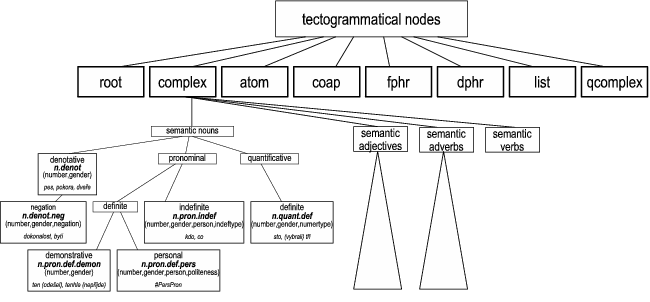Tectogrammatical tree nodes are divided into eight groups; these are called node types. The node types are defined either on the basis of the tectogrammatical lemma (t-lemma, see Chapter 4, Tectogrammatical lemma (t-lemma)) assigned to a node, or on the basis of its functor, or both.
For any node type, essentially the same rules regarding direct daughter nodes (of a given node) apply.
The following node types are recognized:
-
technical root node (see Section 1, "The technical root node"),
-
atomic nodes (see Section 2, "Atomic nodes"),
-
paratactic structure root nodes (see Section 3, "Paratactic structure root nodes"),
-
list structure root nodes (see Section 4, "List structure root nodes"),
-
nodes representing foreign-language expressions (see Section 5, "Nodes representing foreign-language expressions"),
-
nodes representing the dependent parts of idiomatic expressions (see Section 6, "Nodes representing the dependent parts of idiomatic expressions"),
-
complex nodes (see Section 7, "Complex nodes"),
-
quasi-complex nodes (see Section 8, "Quasi-complex nodes"),
The node type information is encoded in the value of the nodetype attribute. The nodetype attribute has eight possible values and applies to every node in the tectogrammatical tree. The attribute values are listed in Table 3.1, "Values of the nodetype attribute".
Table 3.1. Values of the nodetype attribute
root |
technical root node |
atom |
atomic node |
coap |
paratactic structure root node |
list |
list structure root node |
fphr |
node representing a foreign-language expression |
dphr |
node representing the dependent part of an idiomatic expression |
complex |
complex node |
qcomplex |
quasi-complex node |
Node-type hierarchy. The node-type hierarchy is presented in Fig. 3.1. The abbreviations on the second level are the values of the nodetype attribute. Complex nodes are further divided (as the only node type): into four groups (semantic nouns, semantic adjectives, semantic adverbs and semantic verbs). All these categories (semantic word categories/parts of speech), except for the semantic verbs, are further classified. The inner structure of these semantic categories is described in Section 2.1, "Relation between the semantic and traditional parts of speech"; see also Fig. 5.2, Fig. 5.3 and Fig. 5.4.
